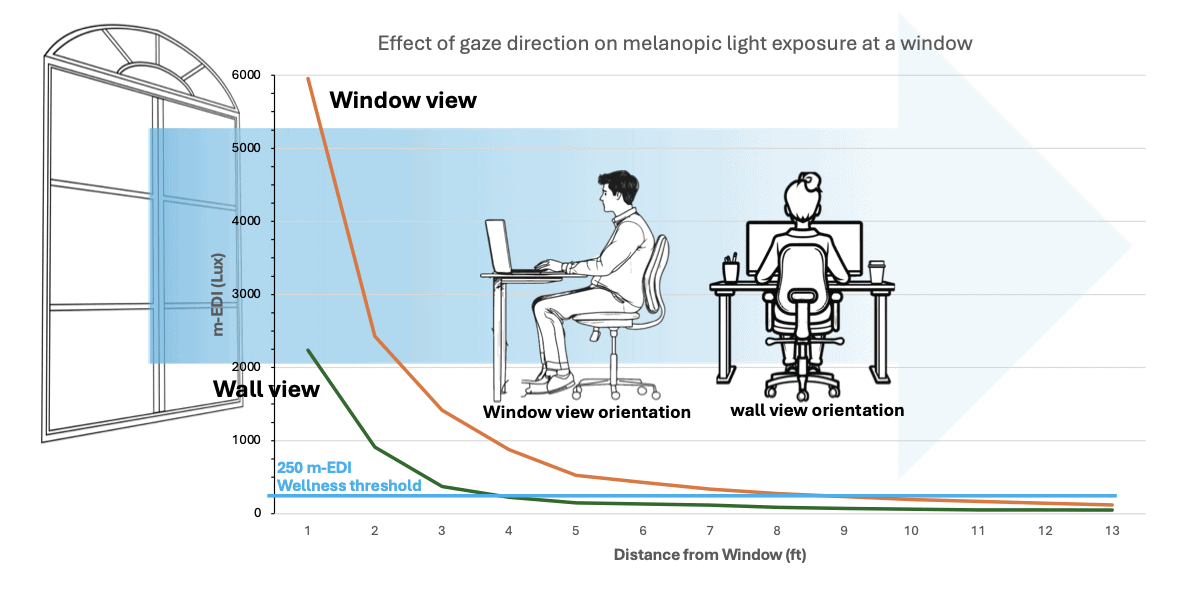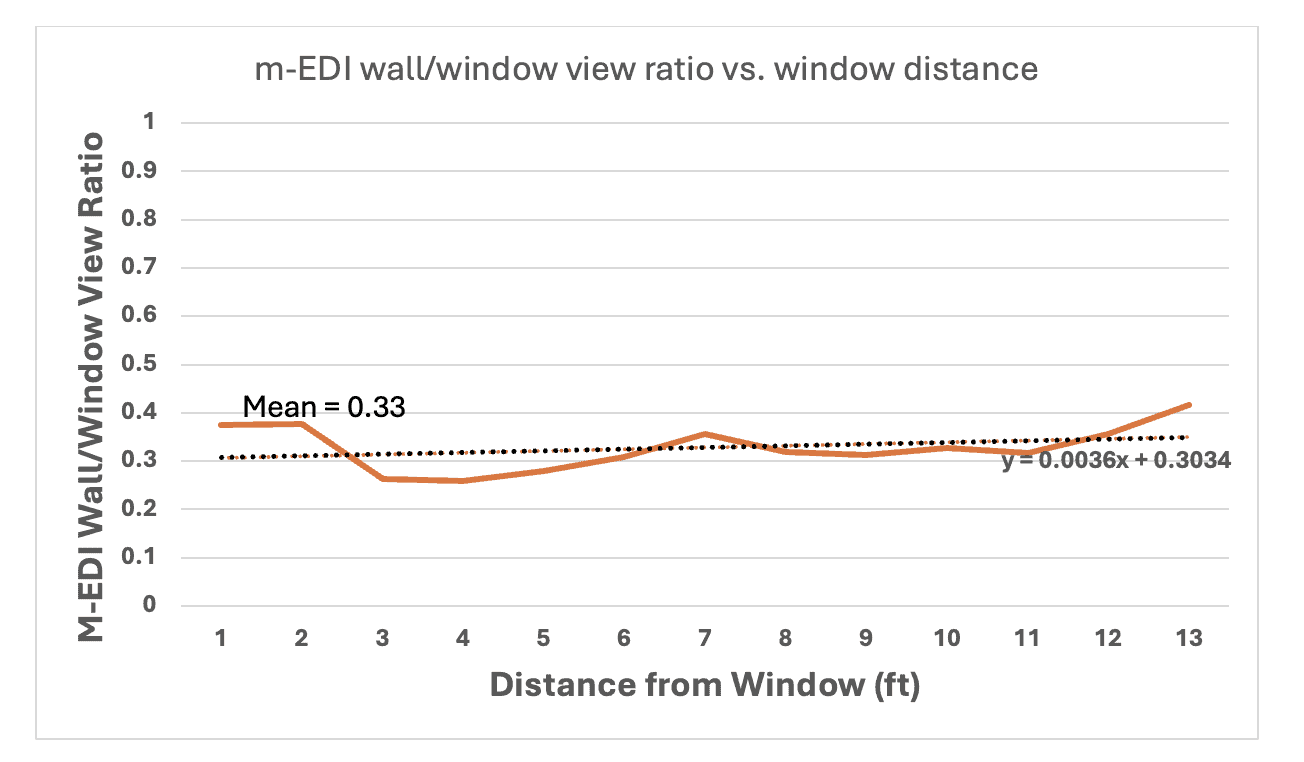One might say that the healing power of nature is real, but it depends on your point of view. This is particularly true of the health benefits of natural light. If we can see the daytime sky, even indoors through a window, we can be reasonably sure that we are getting the melanopic light we need to set and maintain our circadian rhythms, which drive our health and wellbeing. But what if we’re not looking out the window? It turns out that the impact of gaze direction on melanopic exposure is substantial. You could be turning your back on health.
I’m reminded of the classic childhood story, The Secret Garden, where a young, sickly Colin Craven is dramatically transformed each time he encounters nature.
When he faces inward towards his darkened room, he declines.
When he turns outward, toward natural light and the garden, he thrives.
The ‘Secret Power’ of Melanopic Light
It turns out there is real science behind Colin’s improvement. Just like our ancestors millions of years ago, we need exposure to sky-blue, melanopic-rich light regularly during the daytime to anchor our circadian clocks. Given that our modern selves spend more than 90% indoors under melanopic-poor electric lighting, we like Colin, risk reduced energy, mood, and overall wellbeing. And given that the receptors for this melanopic light are in our eyes, it’s most efficacious actually to see the light. Sure, if the skylight coming in is intense enough, the window to wall ratio (WWR) big enough, the interior room surfaces reflective enough, and/or we’re close enough to the window, any direction we view would provide the recommended >250 melanopic daytime light levels as measured by melanopic Equivalent Daylight Illuminance (m-EDI) in lux.
Unfortunately, gaining adequate melanopic exposure through windows is often more wishful than reality, and it frequently literally depends on your viewpoint.
Gaze Direction and Melanopic Exposure
Modern circadian lighting research models and field data show that the path light takes to the eye is as important as the intensity and spectra in determining melanopic exposure (Altenberg & Inanici 2021; Zeng et al. 2021). It turns out that the seemingly inconsequential decision of how close to place a desk to a window and whether to face the chair toward the window or turn 90 degrees could easily negate the health benefits of natural light exposure.

Figure 1. Indoor vertical melanopic light measurements through a clear East window (WWR=49%, Head Height 6’8”) from 2 gaze directions: window view (orange) vs wall view 90° from window (green) at 1.2m height under sunny midday conditions, Carlsbad, CA. The blue line marks the recommended indoor melanopic light exposure threshold.
Measurements of light in an office setting (Figure 1) show that melanopic exposure drops precipitously away from the window. In this field measurement example, adequate melanopic exposure comes only if you are within 8 feet or so of the window and facing it. If one were to orient 90 degrees from the window (a not unreasonable choice, given sunlight glare or a desire for an easier view of the rest of the room), the effect on melanopic exposure would be dramatic. In this study, a 90-degree change in gaze resulted in a two-thirds reduction in Melanopic Equivalent Daylight Illuminance (m-EDI).
Gaze Direction and Window Distance: Compounding the Melanopic Problem
The reduction in melanopic EDI when you turn 90 degrees from the window is significant at 67% and relatively constant with distance from the window (Figure 2).

Figure 2. Ratio of indoor vertical melanopic light measurements of wall view (gaze 90° from window) vs window view facing East at 1.2m height under sunny midday conditions, Carlsbad, CA. The ratio mean of 0.33 remains reasonably constant, regardless of the distance from the window.
The combination of declining melanopic exposure caused by both window distance and view direction means that you would need to be considerably closer to the window in any desk orientation other than directly facing the window still to maintain the wellness threshold (>250 m-EDI). In this example, the 90-degree turn from the window results in a reduction of the minimal window distance for adequate melanopic EDI exposure from 9 feet to 4 feet (blue line, Figure 1).
Simply put, achieving threshold levels of melanopic light using windows can be challenging (Ticleanu et al. 2025). The compounding reduction in melanopic light might be further affected by window transmission factors like tint, shades, visual obstructions, etc.) and colored surface reflectance. One would think that this is where interior lighting comes in; however, the resulting melanopic light deficit in most interior areas is not easily rescued using standard electric lighting or computer monitors. Looking around the middle of a cubicle-filled office, a view outside, perhaps into a secret garden, seems far. The result is inadequate melanopic exposure, which impacts health and wellbeing (Burns et al., 2022; Windred et al., 2024).
Bringing the Feelings of a Blue-Sky Day Indoors, No Matter Where You Gaze
Mary and Colin’s transformation in the Secret Garden begins by turning away from the dull manor interiors and actively seeking the outdoors. While it’s not as logistically easy to bring your desk outside, or the sunny garden indoors throughout the building, it is much easier to bring in the physiological and psychological benefits of high melanopic light. SkyView™ Circadian Lighting is designed to deliver 250 m-EDI light levels in a low glare, natural-feel, 0.4 W/sqft energy efficient illumination everywhere in the building. SkyView™ light democratizes melanopic light exposure, so whereas we all can’t have corner offices with a view into the garden, we all can experience Mary and Colin’s joy, vitality, and wellbeing bathed in healthy light.
“The Secret Garden” author Frances Hodgson Burnett wrote,
“If you look the right way, you can see that the whole world is a garden.”
SkyView™ helps you enjoy the benefits of healthy light, regardless of your perspective. Direct exposure to outdoor light and nature is almost always encouraged. Still, during those indoor times when you need the blue-sky, melanopic light, SkyView™ recreates the sunshine that helps improve your mood, focus, and alertness.
“The robin seemed to say that a bit of sunshine was worth a whole lot of money.”
References
Altenberg Vaz N, Inanici M. Syncing with the sky: daylight-driven circadian lighting design. Leukos. 2021 Jul 3;17(3):291-309.
Burnett, F. H. (1911). The secret garden. F.A. Stokes.
Burns AC, Windred DP, Rutter MK, Olivier P, Vetter C, Saxena R, Lane JM, Phillips AJ, Cain SW. Low daytime light and bright night-time light are associated with psychiatric disorders: an objective light study in> 85,000 UK Biobank participants. medRxiv. 2022 Oct 17:2022-10.
Ticleanu C, Flores-Villa L, Littlefair P, Howlett G. Assessing melanopic equivalent daylight illuminance in office spaces using a simplified approach for predominantly cloudy climates. Lighting Research & Technology. 2025 Feb 24:14771535251317740.
Windred DP, Burns AC, Lane JM, Olivier P, Rutter MK, Saxena R, Phillips AJ, Cain SW. Brighter nights and darker days predict higher mortality risk: A prospective analysis of personal light exposure in> 88,000 individuals. Proceedings of the National Academy of Sciences. 2024 Oct 22;121(43):e2405924121.
Zeng Y, Sun H, Lin B. Optimized lighting energy consumption for non-visual effects: A case study in office spaces based on field test and simulation. Building and Environment. 2021 Nov 1;205:108238.


